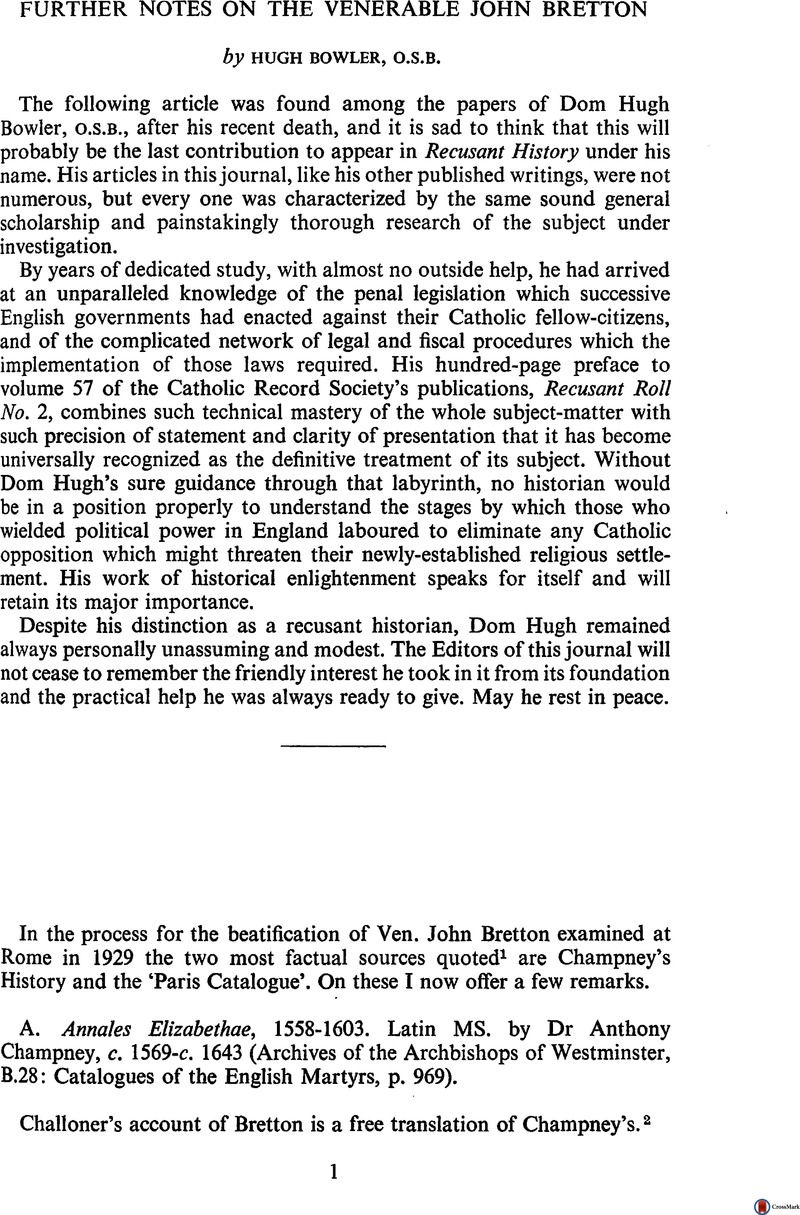No CrossRef data available.
Published online by Cambridge University Press: 11 October 2016

1 Process, vol. 3, ‘Responsio ad novas animadversiones’, pp. 84-86.
2 (Champney's text) ‘Anno Christi 1598. Hoc anno Johannes Brettonus, nobilis, in plaga occidentali comitatus Eboracensis in vico eiusdem nominis natus et familiam tenens, antiquus fidei catholicae cultor, ac proinde a domo sua, uxore et liberis perpetuo fere extorris, cum iam in diebus multis processerat, a malevolo quodam captus et de verbis quibusdam contra Reginam prolatis per calumniam et ex invidia falso accusatus, mortis sententiam sustulit, et quia fidem negare noluit, mortem iuxta latam sententiam passus, martyrii coronam adeptus est Eboraci primo die Aprilis’.
(Challoner's translation) ‘This year (1598), on the first of April, John Britton, gentleman, was executed at York as in cases of high treason. He was born at Britton in the West Riding of Yorkshire, and being of old a zealous Catholic, was, for a great part of his life, exposed to persecutions on account of his conscience, and generally obliged to be absent from his wife and family to keep himself further from danger. At length, being now advanced in years, he was falsely accused by a malicious fellow of having uttered some treasonable words against the Queen, for which he was condemned to die. He refused to save his life by renouncing his faith, and thereupon was put to death’.
3 Peacock, List of Roman Catholics in the County of York in 1604 (1872), p. 3, under ‘Caiethorne parishe’.
4 C.R.S. 22, p. 32. Sandys’ comment is very exceptional.
5 See under ‘Paris Catalogue’ below.
6 Published in the Yorkshire Archaeological Journal, vol. 21.
7 See my former article, ‘Exchequer Dossiers, 2: The recusancy of Venerable John Bretton, gentleman, and of Frances his wife’, Biographical Studies (now Recusant History) 2 (1953-54), p. 116.
8 Borthwick Institute of Historical Research, York. (MSS.): R. VI; A. 6, f. 102—A. 10, f. 243v—A. 13, f. 71. All references in this article to York Diocesan Visitation Books, High Commission books, and wills (preserved at the above Institute) have been transcribed by Dr. J. C. H. Aveling, to whom I am deeply grateful.
9 See my former article, p. 126.
10 Ibid., pp. 115 seq.
11 The will of their father, Richard Bretton (proved January 1562) refers to him as ‘mybastard son’. Test. Ebor.: 17 f. 139v.
12 High Commission Act Book (1576-80), f. 144.
13 Beginning on folio 21.
14 It seems probable, from the evidence of the High Commission and Diocesan Visitation books already quoted, that Frances, the martyr's wife, and all her children, were likewise fugitives from their home throughout this period—even until 1590 (the children returning later still). Had Frances been residing at West Bretton up to 1584, the York Commissioners would certainly have enlisted her aid in preference to that of Robert to discover the whereabouts of her husband. The whole family was away, at any rate, in 1586, when the only Brettons reported by the Visitors for recusancy were ‘Young John’ (Robert's son) and his grandmother, Agnes, who died later that year. In 1590, however, on a similar occasion, we find that Frances has joined ‘young John’, but without her husband and children. Possibly she had returned in the previous year to face the Exchequer commissioners, who, in April 1589, arrived to seize on the Queen's behalf the greater part of the family property (see the former article, p. 116). No clue is available as to where she dwelt during her exile, but it is unlikely, in view of Champney's remark, that she accompanied her husband. She had, indeed, several relatives with whom she and her children could have stayed.
15 S.P. 12/183, no. 37, 21 October 1585.
16 S.P. 12/184, no. 36, 23 November 1585.
17 S.P. 12/183, no. 61, 27 October 1585.
18 P.R.O., E. 372/431, rotulet 40v, ‘Adhuc Res’ Lancastr’.
19 C.R.S. 60, pp. 38-39.
20 Cf. C.R.S. 53, p. 17, under ‘Sandall Magna’.
21 York Diocesan visitations: R. VI; A. 13, f. 71.
22 Ibid., R. VI; A. 16, f. 80v.
23 York Minster Library, MS. B, B. 53.
24 Cf. Challoner, Memoirs of Missionary Priests, (ed. 1924), e.g. pp. 125, 130, 135, 140.
25 Probably (thinks Fr B. FitzGibbon, S.J.) William Harewell, als. Farrar, priest and notary, secretary to Richard Smith, Bishop of Chalcedon; cf, C.R.S. 10. He was actively engaged inthe work of investigation referred to below. Cf. C.R.S. 5, p. 393.
26 C.R.S. 5, p. 393.
27 Bretton is mentioned in no fewer than eleven of the catalogues of martyrs.
28 This was apparently also Challoner's view, since he does not quote him.
29 See marginal note [3],
30 Cf. Cordy Jeaffreson, Middlesex County Records, vol. 2, Introd., pp. xv-xvii. There were no Assizes in London; instead, Newgate Gaol-delivery Sessions. This ‘Gaol-delivery Register’ is probably the authority cited by Bishop Smith as ‘Registrum Careens Neoportensis’ in his accounts of several Tyburn martyrs. The counterpart volumes for London cases (as distinct from those of Middlesex) have unfortunately disappeared.
31 Pp. 111 and 130, note 6.
32 Statutes of the Realm.
33 Jacob, Law Dictionary, under ‘felony’.
34 The penultimate section repeals the Act 1 and 2 Philip and Mary, cap. 3 (1554) against this ty0e of offence (for which the penalty prescribed was a fine and imprisonment), and also the Act 1 Eliz., cap. 6 (1558), which continued it under Elizabeth. The final section lays down thatthe present Act of 1581 shall remain in force during the lifetime of the Queen.